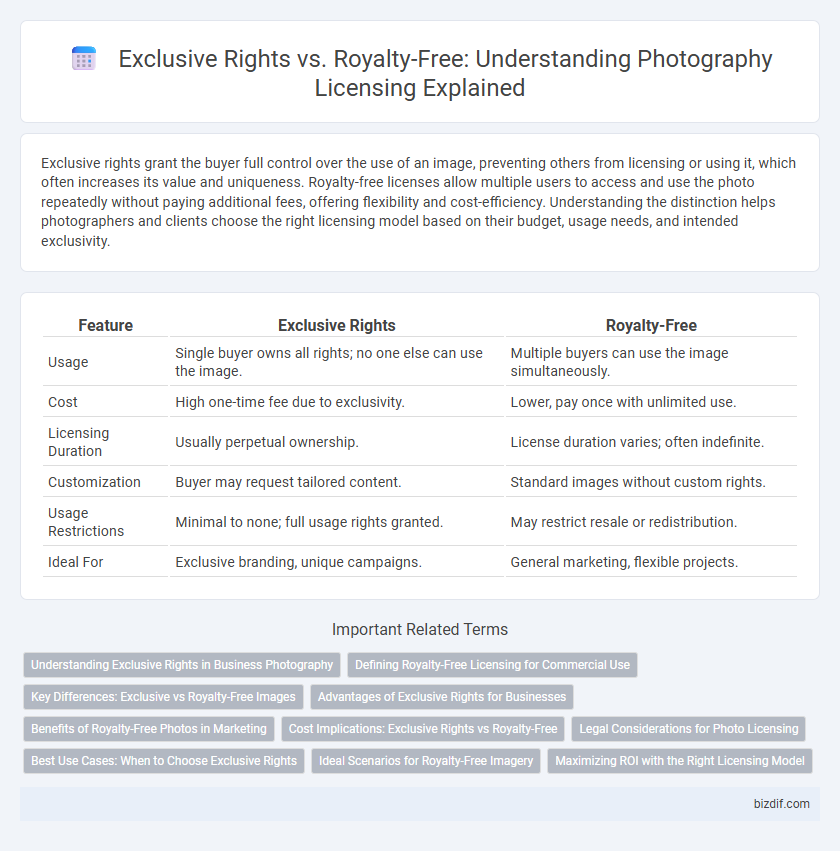Exclusive rights grant the buyer full control over the use of an image, preventing others from licensing or using it, which often increases its value and uniqueness. Royalty-free licenses allow multiple users to access and use the photo repeatedly without paying additional fees, offering flexibility and cost-efficiency. Understanding the distinction helps photographers and clients choose the right licensing model based on their budget, usage needs, and intended exclusivity.
Table of Comparison
| Feature | Exclusive Rights | Royalty-Free |
|---|---|---|
| Usage | Single buyer owns all rights; no one else can use the image. | Multiple buyers can use the image simultaneously. |
| Cost | High one-time fee due to exclusivity. | Lower, pay once with unlimited use. |
| Licensing Duration | Usually perpetual ownership. | License duration varies; often indefinite. |
| Customization | Buyer may request tailored content. | Standard images without custom rights. |
| Usage Restrictions | Minimal to none; full usage rights granted. | May restrict resale or redistribution. |
| Ideal For | Exclusive branding, unique campaigns. | General marketing, flexible projects. |
Understanding Exclusive Rights in Business Photography
Exclusive rights in business photography grant the client sole ownership and control over the use of images, preventing the photographer from licensing the photos to others. This arrangement often involves a higher fee but ensures brand uniqueness and competitive advantage through exclusive visual content. Understanding exclusive rights is crucial for businesses aiming to protect their visual assets and maintain a distinct market presence.
Defining Royalty-Free Licensing for Commercial Use
Royalty-free licensing allows businesses to use photographs multiple times for commercial purposes without paying recurring fees, providing cost-effective flexibility. This licensing grants a broad range of usage rights, including advertising, marketing, and digital media, while maintaining ownership of the image with the photographer or agency. Understanding royalty-free terms ensures companies can legally incorporate visuals in products, campaigns, and websites without negotiating exclusive permissions.
Key Differences: Exclusive vs Royalty-Free Images
Exclusive rights grant a single buyer full control and usage of an image, preventing others from using it, while royalty-free licenses allow multiple users to access the same photo without recurring fees. Exclusive images offer unique branding opportunities and higher market value due to their uniqueness, whereas royalty-free images provide cost-effective flexibility for repeated use across various projects. Choosing between exclusive and royalty-free depends on the intended usage scope, budget, and need for distinctiveness in marketing or creative work.
Advantages of Exclusive Rights for Businesses
Exclusive rights ensure businesses full control over image usage, preventing competitors from leveraging the same visuals and strengthening brand identity. These rights enable unique marketing campaigns and foster a consistent, distinctive visual presence. Securing exclusive rights protects investments in high-quality photography, enhancing long-term brand value and customer recognition.
Benefits of Royalty-Free Photos in Marketing
Royalty-free photos provide marketers with cost-effective, unlimited usage rights, eliminating the need for repeated licensing fees and enhancing budget efficiency. These images offer flexibility for diverse campaigns across digital, print, and social media platforms without additional legal constraints. Access to a vast library of royalty-free photos accelerates content creation and supports consistent brand messaging with high-quality visuals.
Cost Implications: Exclusive Rights vs Royalty-Free
Exclusive rights licensing typically involves higher upfront costs since the buyer obtains full control over the image, preventing others from using it. Royalty-free licenses offer more affordable pricing with repeated usage allowed without additional fees, but the image can be sold to multiple users simultaneously. Businesses must evaluate budget constraints and intended image use frequency when choosing between exclusive and royalty-free licenses.
Legal Considerations for Photo Licensing
Exclusive rights grant the licensee sole usage of a photograph, preventing the photographer from licensing the image to others, which legally restricts market competition and ensures unique control over distribution. Royalty-free licenses allow multiple users to access the same image without time constraints but limit exclusive legal protections and often lack territorial or usage specificity. Understanding these legal distinctions is crucial for photographers and clients to protect intellectual property, avoid infringement disputes, and define clear usage terms in photo licensing agreements.
Best Use Cases: When to Choose Exclusive Rights
Exclusive rights are best suited for high-impact commercial projects requiring unique, unrestricted use, such as national advertising campaigns and branded content where exclusivity boosts brand identity. They are ideal when a business needs complete control over an image to prevent competitors from using the same visual asset. Opting for exclusive rights ensures the image remains distinctive, supporting premium branding and market differentiation.
Ideal Scenarios for Royalty-Free Imagery
Royalty-free imagery is ideal for businesses and content creators needing versatile, cost-effective visuals with unlimited usage across multiple projects without recurring fees. This licensing type benefits websites, social media campaigns, and marketing materials requiring high-quality images without exclusivity constraints. It supports streamlined budgeting and rapid deployment where exclusive control over the image is not a critical factor.
Maximizing ROI with the Right Licensing Model
Choosing exclusive rights grants photographers full control and higher revenue per sale, maximizing return on investment by limiting image distribution to a single buyer. Royalty-free licenses enable broader usage across multiple clients, increasing volume sales but often reducing individual transaction value. Understanding market demand and client needs helps optimize profit by balancing exclusivity and wide accessibility.
Exclusive Rights vs Royalty-Free Infographic

 bizdif.com
bizdif.com